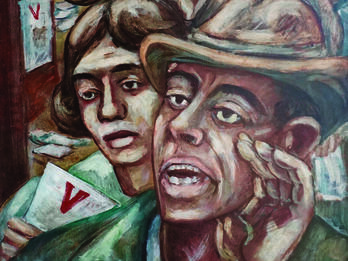Geography and Genre, 1939–1973
Postwar Jewish culture developed unevenly across regions, and language and political concerns shaped local interests.
During the years of the Holocaust, geography literally meant the difference between life and death, while after the war, Jews in different parts of the world fashioned diverse cultures even as they shared common concerns. In the postwar Jewish world, the pace of cultural cross-fertilization was quite uneven, greater in scholarship than in fiction, in religious thought than in poetry or life writing. For example, for decades much of the extraordinary cultural creativity of the ghettos in Nazi-occupied Europe was largely ignored outside the narrow circles of Yiddishland, resurfacing only many years later. Elie Wiesel’s memoir of Auschwitz attracted little notice when it was published in Yiddish in 1956. But two years later, its French version, with less Jewish anger and a more universal pathos, became a publishing sensation.
As genres traveled in time and space, they morphed in unpredictable ways. Popular song played a critical role in shaping a common Israeli identity; behind the Iron Curtain, folk songs remained one of the few forms of allowed Jewish expression. But this genre was less important in the United States or Europe. And as Ziva Amishai Meisels has pointed out, Jewish art rooted in Jewish folk motifs and historical themes really developed in only two places: Israel and Russia.
Some genres traveled through the Jewish world with relative ease. Gershom Scholem’s pathbreaking scholarship on Jewish mysticism, Jacob Katz’s fresh historical insights into the decline of Jewish traditional society in Europe, and Yehezkel Kaufmann’s thesis of the salience of monotheism in Jewish survival all found wide and receptive audiences in translation. Post-Holocaust theology, Hannah Arendt’s controversial assertions about the banality of evil and genocide, and the philosopher Abraham Joshua Heschel’s explorations of the layers of religious experience and his call for a God-centered theology did not remain confined to time and place. Philosopher Martin Buber’s I and Thou, first published in German in 1923, was widely read in English translations, reaching new audiences. Scholar Erich Auerbach’s Mimesis became an instant classic and is studied to this day. Poets in Yiddish and Hebrew, however, had to wait for many decades before they found an audience outside their original languages through translation. Playwrights fared even worse. Hanoch Levin, Israel’s greatest political satirist, whose plays were routinely heckled, condemned, and censored, was virtually unknown to non-Hebrew-speaking audiences during his extraordinarily productive but all-too-brief career.
Jewish humor is a genre that hardly traveled at all. Humor is an invaluable historical artifact, full of cultural and psychological insights. But the reader judges whether jokes told in the Warsaw ghetto, Israel, or even the United States are funny outside their particular time and place.
Well into the 1960s, Yiddish was still the language that most easily crossed borders and continents; the new Hebrew culture, though, found little echo outside of Israel. As late as 1960, the leading American Jewish journal, Commentary, rejected an article about the great Hebrew writer S. Y. Agnon, who would go on to win a Nobel Prize in Literature, because the editorial board considered him too obscure. In 1963, the American Jewish Congress actually sponsored a symposium on why Israeli and American Jewish writers knew so little about each other’s literatures.
Yet shared concerns and interests across the Jewish world were on the rise. The 1961 trial in Israel of Adolf Eichmann, a leading Nazi organizer of the mass murder of Jews, provoked more interest in the Holocaust and its survivors; Hannah Arendt’s Eichmann in Jerusalem sent shock waves throughout the Jewish world. Israel’s Six Day War in 1967 forced Jews everywhere to confront the existential significance of a Jewish state as well as the relative indifference of many of their non-Jewish friends.
The year 1968 proved another major turning point. The worldwide social and cultural turmoil of the 1960s—antiwar protests, student unrest, the civil rights movement, feminism—had a deep impact, especially on young Jews in Europe and North America whose Jewish identities were challenged as never before by new sensibilities and generational revolt. Most listeners might not regard Bob Dylan’s “Like a Rolling Stone” as a “Jewish song,” but its new voice, provocative and confrontational, evoked the defiance and disorientation that an entire generation was feeling. In the United States, Jews responded in unexpected ways: through a Jewish feminism, the havurah movement, a rethinking of alliances between Jews and Blacks, and a reappraisal of Jewish liberalism. In the Soviet Union, the double impact of the Six Day War and the collapse of any hopes of internal reform that followed the 1968 Soviet invasion of Czechoslovakia signaled the first stirrings of revolt and defiance within the third-largest Jewish community in the world.



